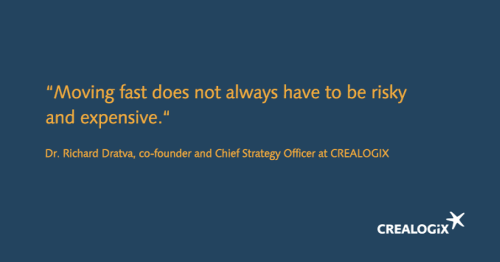Richard Dratva: «Digital Banking in the 2020s»
Five counterintuitive digital strategies for incumbent financial brands to thrive.
By Dr. Richard Dratva is co-founder and Chief Strategy Officer at the digital banking software specialist CREALOGIX.
The positive but disruptive changes of the digital era are putting established financial brands under pressure to act – but the tried and trusted recipes of banks and wealth management firms are often leading into a dead end since if the strategies used are based on old habits from the analog age.
Established financial institutions do what intuitively seems right to them against the background of their business practices, operating principles and processes that have evolved over decades – yet these established approaches are often are mistaken in the digital era. Nevertheless, with the right ability to challenge convention, it’s easy to find solutions for the bank of tomorrow. This article presents five simple yet counterintuitive digital strategies for established financial brands in the 2020s.
CREALOGIX: Download White Paper «5 Counterintuitive Digital Strategies»
Visible Improvements for Customers Instead of Invisible Internal Tweaking
Compared to the challengers, established financial institutions are currently one thing above all: slow. This is mainly due to their technological infrastructure. Under the surface, incumbents struggle with the complexity and costs of hundreds of different systems that they have to maintain for day-to-day operations – and therefore dedicate most of their technology budgets to the maintenance of their existing systems.
However, this disproportionate cost of legacy systems eats up the valuable resources needed to create new useful features that their customers can see or feel, which add up to make a digital user experience that can compete with the sleek offerings of the challengers.
Banks need to be much more aggressive about prioritizing the delivery of tangible improvements for the end customer. Modernizing the underlying systems is important, but innovation is even more important – and, in order to be innovative, the existing resources must be radically redistributed. Moreover, a budget boost in this area will send a clear message to the company's teams that rhetoric must turn into action.
Offer Choice Instead of Clutter
CREALOGIX: Download White Paper «5 Counterintuitive Digital Strategies»
It is easier for established companies to add new products and services to their portfolio than to remove existing offerings. That's why many established banks and wealth management firms have accumulated an immense clutter of accounts, cards, tariffs, price levels and services – in the interest of the customers, of course, because they certainly appreciate this wide choice, don't they?
The truth is that customers quickly feel overwhelmed by too many options. Moreover, financial institutions can only become faster and more innovative if they become leaner and more focused – in other words if they radically reduce the number of options within their portfolio.
It is, therefore, a counterintuitive strategy to simplify the customer journey as much as possible because simplicity means convenience, and convenience is the biggest driver of loyalty in the digital world. However, one size doesn’t fit all. Successful banks will have to personalize their user experiences instead of constantly showing all options to all customers.
Focus on Open Finance Instead of a Siege Mentality
Established financial institutions often take a defensive stance against open banking, for this means that they have to share their greatest treasure – their customer data – with potential competitors. For this reason, many banks consider it rational to limit the opening of their systems to the bare minimum, just enough to satisfy open banking regulation.
This is a legacy thinking trap, too, because in the future the real drivers of open finance will not be the regulators, but the bank clients – and the bank clients know what they want: a banking experience that is corresponding to their digital lifestyles.
The financial world of tomorrow is hyperconnected – thus it is better to become part of this connection early on than to fight it. The key to future success will be to use third party data intelligently rather than just make your data available to third parties. Be it energy, mobile phone contracts or media services: many bank customers can readily see themselves purchasing non-financial products from their bank.
This enables established financial brands to tap into new digital sources of revenue by offering additional services. But beware: open finance does not happen by itself! The more you experiment with the new possibilities of open finance, the more successful you will be.
Challenge the Challengers Instead of Going Into Rigor Mortis
CREALOGIX: Download White Paper «5 Counterintuitive Digital Strategies»
Established financial brands often shy away from challenger-style innovations because they fear that radical changes could jeopardize their institution's brand, reputation and identity. In view of this risk, they prefer doing «business as usual» and build a conservative self-image that seeks to justify doing business incautious, slow, manual ways. Banks and wealth management firms that follow this path want to risk as little as possible – yet they are possibly risking everything. Whilst the neobanks are continuing to win tens of thousands of new customers each day, established financial institutions have less and less capability to counter this disruptive transformation from a «business as usual» stance.
A counterintuitive strategy for banks is to investigate what exactly makes the challengers so successful – and then launch a semi-independent flanker brand (also known as successor brand) to be able to experiment with new technologies, new ways of thinking and new customer segments which are independent of the main brand. The big advantage of this: for a flanker brand, moving fast does not always have to be risky and expensive.
Focus on Innovations in «Fin» Instead of Reinventing «Tech»
Fintechs are often by nature more «tech» than «fin». They impress above all with their technological competence, their customer-oriented design thinking and their ability to find new solutions for old problems. Many established financial institutions believe that they have to become Silicon Valley-style technology companies themselves in order to be able to cope with the new digitally-native competitors.
They are hiring hundreds of developers and building out their IT infrastructure – but is this really necessary? In fact, established financial brands should focus on their core competencies: the development and distribution of financial products and services. Technology is only a means to an end and can be outsourced by banks to a strong ecosystem of specialized financial technology providers – another way to become faster, more flexible and successful in the digital age.
Dr. Richard Dratva is co-founder and Chief Strategy Officer at the digital banking software specialist CREALOGIX.














